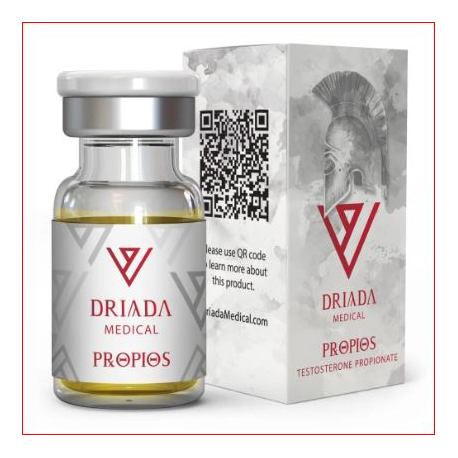Propios 100 mg/ml (Testosterone Propionate)
28,90 €
New product
Description:
Testosterone, vital for reproductive tissue development and secondary sexual characteristics, is essential for health, preventing conditions like osteoporosis. Used medically for gender dysphoria, male hypogonadism, and certain breast cancers.
More info
Description
In sports, it enhances muscle mass and strength, but misuse can lead to adverse effects like increased blood pressure and aggression. Proper dosages, monitoring, and storage are crucial.
Mechanism of Action:
Testosterone binds to androgen receptors and acts as a precursor to dihydrotestosterone (DHT), a biologically active androgen formed through the action of the enzyme 5α-reductase on testosterone. DHT exhibits a higher affinity for androgen receptors than testosterone, triggering changes in gene activity and mediating androgenic effects. Additionally, testosterone can convert to estrogen via aromatization, with estrogens primarily regulating feedback mechanisms and suppressing endogenous testosterone secretion when exogenous testosterone is administered.
Medical Use:
Included in the World Health Organization's essential medicines list, testosterone is vital for basic healthcare. It serves as a medication for treating gender dysphoria, male hypogonadism, and specific breast cancers. Hormone replacement therapy (HRT) or testosterone replacement therapy (TRT) may be necessary to maintain normal testosterone levels, particularly as men age and experience declining testosterone production. Such therapy can enhance well-being, sexual function, and overall body composition.
Testosterone for Seniors:
Men aged 35 and above, experiencing a decline in well-being, often undergo testosterone level tests. If levels fall below 12 nmol/l, hormone replacement therapy may be recommended. This approach yields positive effects such as improved body composition (reduced fat, increased muscle mass), rejuvenated sexual function, and reversal of negative effects linked with androgen deficiency. Regular monitoring of lipid profiles, blood parameters, estradiol, and prolactin levels is crucial. Moreover, individuals desiring offspring may require specific therapy with gonadotropins.
Testosterone in Sports:
Testosterone's primary advantage in sports lies in its capacity to augment muscle mass and strength, exhibiting both anabolic and androgenic effects. It interacts with androgen receptors, altering gene expression and protein synthesis. Additionally, testosterone can enhance water retention, joint health, regeneration processes, and oxygen-carrying capacity in the blood. Dosages in sports typically range from 250 to 500 mg per week, adjusted based on an athlete's body weight, with cycles lasting 8 to 10 weeks, followed by post-cycle therapy. Regular monitoring of estradiol levels and the use of aromatase inhibitors are crucial to manage potential estrogenic side effects.
Dosages:
- Beginner: 50 mg every other day (E OD)
- Average Dosage: 100-150 mg EOD
- High Dosage: 100 mg or more per day (ED)
Effects:
- Increased muscle mass
- Development of male genital organs and secondary sexual characteristics
- Spermatogenesis and male sexual behavior
- Enhanced muscle strength
- Reduction in blood cholesterol levels
- Lower risk of heart ischemia and coronary heart disease
- Stimulation of erythropoiesis
- Influence on nitrogen and phosphorus metabolism
Side Effects:
- Increased blood pressure
- Heightened sexual behavior
- Increased blood clotting tendency
- Possible formation of blood clots in arteries and veins
- Water retention (edema)
- Masculinization effects
- Aggression, agitation, irritability
- Alopecia (baldness)
- Acne
- Insomnia (rare)
Profile:
- Half-life: 20 hours
- Frequency of Injections: 1-2 days
Pharmaceutical Form:
- Oily solution for intramuscular injection
Contraindications:
- Pregnancy
- Known or suspected carcinoma of the prostate or breast
- Breastfeeding
- Hypersensitivity to the active substance or any excipients
How to Store:
- Do not use after the expiry date
- Store between 8º to 30ºC
- Avoid freezing
- Protect from light





